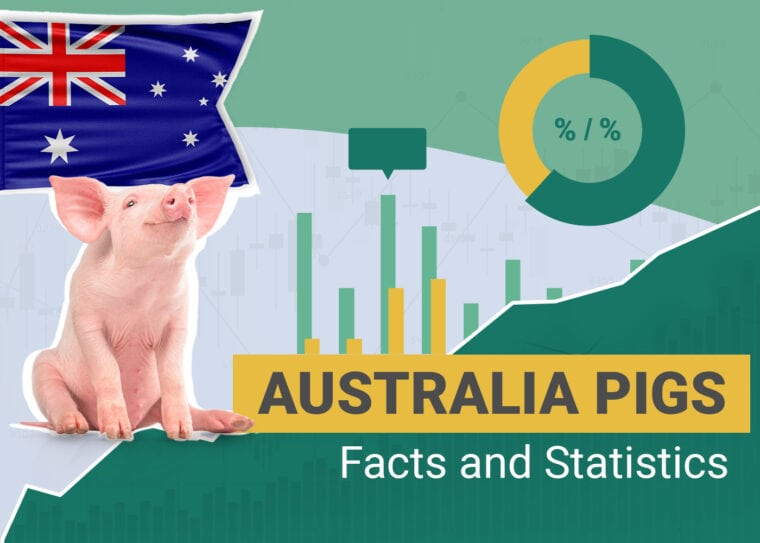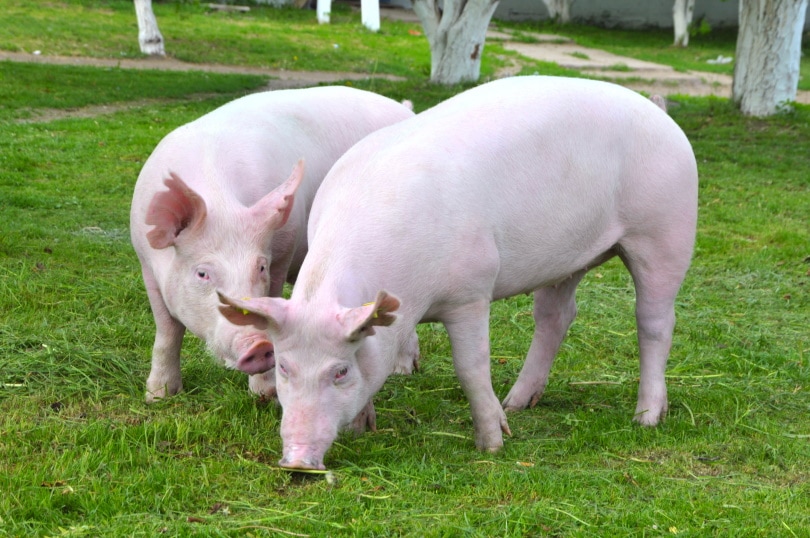
Click to Skip Ahead
Note: This article’s statistics come from third-party sources and do not represent the opinions of this website
Pigs are a non-native species that were introduced to the land down under by European settlers in the 18th century. With few indigenous predators on the ground to turn stray pigs into a meal, pigs quickly went feral and spread over large parts of western and northern Australia. Although this feral population is larger than the population of farmed pigs, it is the farmed pigs that most people are focused on. There are approximately 2.4 million pigs on Australia’s farms. Pigs are reared primarily for domestic pork production, with only a relatively small volume destined for export markets in Asia.
Read on to find out how many pigs there are in Australia and other fascinating porcine facts you might not know.
The 13 Statistics About Pigs in Australia
- There are approximately 2.4 million pigs in Australia’s herds at any given time.
- Breeding sows make up a little over 10% of Australia’s pig herds at around 265,000 sows.
- There are eight pure breeds of pig remaining in Australia.
- Typically, pigs are raised for 5–6 months until they weigh around 60 kgs before they are slaughtered.
- In 2022, 5.49 million pigs were slaughtered in Australia.
- African Swine Fever has never infected pigs in Australia.
- Domestic pigs arrived in Australia in 1788 and went feral.
- There are 4.4 million feral pigs in Australia.
- Feral pigs cause $100 million in damage to the agriculture industry per year.
- Feral pigs cover half of the Australian continent.
- In 2020–21 Australians, on average, consumed 10.8 kgs each of fresh pork.
- Only 9% of Australia’s pork is exported.
- Singapore and Papua New Guinea account for 2/3 of Australia’s exports.

 Farmed Pigs in Australia
Farmed Pigs in Australia
1. There are approximately 2.4 million pigs in Australia’s herds at any given time.
(Australian Pork)
In Australia, the farmed herd size grew from about 2.2 million in the mid-1970s to 2.9 million in the early 2000s. After that period, the herd shrunk to a record low of 2.1 million in 2012, caused by a mixture of industry rationalization and high feed prices. Since then, the herd size has grown slightly and is currently stable at around 2.4 million head of pigs.

2. Breeding sows make up a little over 10% of Australia’s pig herds at around 265,000 sows.
(Thomas Elder Markets State of the Industry Report 2021)
Breeding sows in Australia make up a small but significant part of the country’s pig herd, representing just over 10% of the total number. At present, approximately 265,000 breeding sows are kept in Australia for pork production. On average, sows have 2.4 litters per year, each litter producing between 9 and 13 pigs. Although few in number, the quantity and quality of the sows in the Australian pig herd are crucial for Australia’s consumers of fresh and processed pork products.
3. There are eight pure breeds of pig remaining in Australia.
(New South Wales Government Department of Primary Industries)
To maintain biosecurity and keep new diseases and pathogens from entering Australia, imports of live pigs and pig semen are not allowed. There are eight pure breeds of pig remaining in Australia from the original pigs imported by settlers. Three are common in commercial pork production: the Landrace, Large White, and Duroc. The other five breeds, Tamworth, Wessex Saddleback, Hampshire, Berkshire, and Large Black, are mainly reared outdoors, although some of these breeds are quite rare.

4. Typically pigs are raised for 5–6 months until they weigh around 60 kgs before they are slaughtered.
(RSPCA Australia)
When pigs are born, they are much smaller than you might imagine—about 1 kg. To get to 60 kgs, they have to double their body weight seven times in six months. Pigs are omnivores and will eat a wide range of foods, but like humans, they have a single stomach and are inefficient at digesting fibre. Cereal grains, such as wheat, barley, and lupin beans, are the mainstay of pig diets in Australia, although peas, canola meal, and triticale are also used.
5. In 2022, 5.49 million pigs were slaughtered in Australia.
(Statista)
Once pigs reach their target weight, they will be slaughtered in licensed, regulated abattoirs. The control and regulation of how animals meet their end is an important part of animal welfare. With 2.4 million pigs in the herd at any one time and 5.49 million pigs slaughtered per year, it means that the herd turns over about three times each year. This means most Australian pigs live incredibly short lives.

6. African Swine Fever has never infected pigs in Australia.
(Australian Government Department of Agriculture, Fisheries and Forestry)
African Swine Fever (ASF) is a contagious viral disease that affects both domestic and wild pigs. ASF is harmless to humans. There is no vaccine for ASF, and it can kill between 80% and 100% of infected pigs. Currently, the disease is devastating pig production in herds around the world. Originally only found in Africa, it spread to Europe in the 1950s before going on to infect other parts of the world. The latest widespread outbreak has been reported so far in:
ASF has never occurred in Australia, and Australia has measures in place to try and prevent the import of ASF.
Feral Pigs in Australia
7. Domestic pigs arrived in Australia in 1788 and went feral.
(NSW Government Department of Primary Industries)
The First Fleet brought European and African settlers to Australia. They brought with them various types of livestock, of which pigs were the only ones that thrived. Pigs were generally kept without enclosures until the 1860s when property fencing started to become common. Without boundaries to stop them, many pigs wandered off and became feral.
A hundred years after domestic pigs first arrived in Australia, feral pigs were widespread throughout much of New South Wales. Extended periods of high rainfall had enabled the pigs to disperse into areas where they had not previously been introduced by following water courses, particularly into the state’s western regions.

8. There are 4.4 million feral pigs in Australia.
(National Feral Pig Action Plan 2021–2031)
Feral pigs are adaptable and thrive in a wide range of environments. Part of what makes them so adaptable is their ability to change and survive on different foods. This has allowed them to inhabit tropical and temperate rainforests, monsoon forests, swamps, open floodplains, marshes, coastal fringes, semi-arid floodplains, dry woodlands, subalpine grasslands, and many crop-growing areas. You name the environment, and pigs will figure out how to live there. Population size in each of these habitats is affected by rainfall and the availability of food. This versatility and variation have made it very hard to accurately calculate population sizes, and previous studies ranged from 3 million to 24 million, a very wide range! The latest study for the National Feral Pig Action Plan 2021-2031 estimates the population at 3.3-4.4 million pigs.
9. Feral pigs cause $100 million in damage to the agriculture industry per year.
(National Feral Pig Action Plan 2021–2031)
Feral pigs destroy land, crops, pastures, and water sources. They threaten biosecurity through the spread of weeds in their dung and the transmission of diseases to livestock, plants, and humans. They also threaten the natural environment and culturally important Indigenous sites and damage and contaminate water sources. Agricultural industries in Australia, including bananas, beef, cereal, cotton, horticulture, lamb, pork, pulses, sugar, and wool, are all impacted by feral pigs to the tune of about $100 million per year.

10. Feral pigs cover half of the Australian continent.
(Australian Government Department of Agriculture, Fisheries, and Forestry)
Feral pigs do not have the ability to regulate their body temperature and need water to wallow in to keep cool. By following the water courses during wet periods, feral pigs have been able to spread over about half of Australia, from Western Victoria through New South Wales into Queensland and across northern Australia. It’s only the deep arid landmass of Australia that is impenetrable to these plucky pigs.
 Pork Consumption
Pork Consumption
11. In 2020–21 Australians, on average, consumed 10.8 kgs of fresh pork.
(Australian Pork)
Every year in Australia, about 706 million pork meals are eaten. That’s a lot of sausages! This works out to the equivalent of each person in Australia eating 10.8 kgs of fresh pork every year. When you think of Australia’s love of barbecues—not to mention snags—this statistic may prove less shocking. It’s clear that since their arrival here in the 18th century, pigs have provided a significant portion of the continent’s substantial protein needs.

12. Only 9% of Australia’s pork is exported.
(Thomas Elder Markets State of the Industry Report 2021)
Australia is a net importer of pork, and only a small part—less than 10% in total—of domestic production is exported, most of it going to Asia, where it is highly regarded for its quality and health standards. This is likely because Australian animal husbandry and farming regulations are extremely well regarded all over the world, with a perception that herds are well protected from disease and agricultural practices are safe for humans.
13. Singapore and Papua New Guinea account for 2/3 of Australia’s exports.
(Thomas Elder Markets State of the Industry Report 2021)
Singapore is Australia’s largest pork export market, accounting for about 55% of pork exports. Papua New Guinea, which is right on Australia’s doorstep, accounts for another 12%. Another 23% goes to other countries in Asia. From a geographic viewpoint, it makes sense that most of Australia’s pork stays relatively close to home. Exports to the rest of the world make up the remaining 10%. Exports are worth about $13 million to the Australian economy annually.

Frequently Asked Questions About Pigs
Which Country Has the Most Pigs?
China is the global leader in rearing pigs and producing pork. In April 2022, China had about 450 million pigs across the country in its pig herds. China, with the largest population in the world, is also the world’s largest importer of pork. Since the latest outbreak of African Swine Fever reached China in 2018, China’s population of pigs has suffered, resulting in about 46 million fewer pigs being slaughtered per year. Such a shortfall has proved almost impossible for the rest of the world to make up, especially as many other countries are also suffering from ASF outbreaks.
What Is the Global Population of Farmed Pigs?
The global population of farmed pigs in April 2022 was about 784 million heads, with China being by far the largest producer, with nearly 60% of the world’s pigs. The European Union and the United States of America have the next biggest herds, with 141 million and 74 million, respectively. Brazil, Russia, Canada, and South Korea all have sizable pig populations as well, numbering from about 35 million to 10 million pigs each.

Are Pigs Smarter Than Dogs?
Pigs might be the fifth smartest animal on the planet, ahead of dogs. They have been used both as sheep herders and guard animals—just like dogs—and of course, people keep them as pets as well, although their full-grown size can make sharing a couch with a pig problematic. Pigs have been known to recognize the sound of the engine of the car their farmer drives or identify by sound when electric fences are down. Pigs have even been taught to play video games!
Conclusion
Australia is home to a large population of pigs, with more pigs living wild than on pig farms. Aussie pigs have had a long time to settle in. Pigs were first introduced to the continent in 1788, and it is estimated that there are between 3.3 and 4.4 million feral pigs and 2.4 million farmed pigs across Australia. While pigs are not present in numbers as significant as the cattle and sheep industries, nevertheless, pork production is an important part of Australia’s agricultural sector, providing pork to meet Australia’s large domestic demand.

 Farmed Pigs in Australia
Farmed Pigs in Australia




